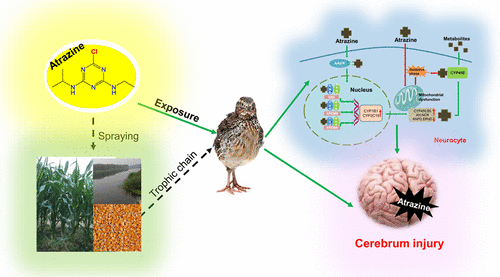当前位置:
X-MOL 学术
›
J. Agric. Food Chem.
›
论文详情
Our official English website, www.x-mol.net, welcomes your
feedback! (Note: you will need to create a separate account there.)
Atrazine Triggers Mitochondrial Dysfunction and Oxidative Stress in Quail (Coturnix C. coturnix) Cerebrum via Activating Xenobiotic-Sensing Nuclear Receptors and Modulating Cytochrome P450 Systems
Journal of Agricultural and Food Chemistry ( IF 5.7 ) Pub Date : 2018-06-05 00:00:00 , DOI: 10.1021/acs.jafc.8b01413 Jia Lin , Hua-Shan Zhao , Lei Qin 1 , Xue-Nan Li , Cong Zhang , Jun Xia , Jin-Long Li
Journal of Agricultural and Food Chemistry ( IF 5.7 ) Pub Date : 2018-06-05 00:00:00 , DOI: 10.1021/acs.jafc.8b01413 Jia Lin , Hua-Shan Zhao , Lei Qin 1 , Xue-Nan Li , Cong Zhang , Jun Xia , Jin-Long Li
Affiliation

|
The residues from the widely used broad-spectrum environmental herbicide, atrazine (ATR), result in the exposure of nontarget organisms and persist as a global major public health hazard. ATR is neurotoxic and may cause adverse health effects in mammals, birds, and fishes. Nevertheless, the molecular mechanism of ATR induced neurotoxicity remains unclear. To assess the molecular mechanisms of ATR-induced cerebral toxicity through potential oxidative damage, quail were treated with ATR by oral gavage administration at doses of 0, 50, 250, and 500 mg/kg body weight daily for 45 days. Markedly, increases in the amount of swelling of neuronal cells, the percentage of mean damaged mitochondria, mitochondrial malformation, and mitochondrial vacuolar degeneration as well as decreases in the mitochondrial cristae and mitochondrial volume density were observed by light and electron microscopy in the cerebrum of quail. ATR induced toxicities in the expression of mitochondrial function-related genes and promoted oxidative damage, as indicated by effects on oxidative stress indices. These results indicated that ATR exposure can cause neurological disorders and cerebral injury. ATR may initiate apoptosis by activating Bcl-2, Bax, and Caspase3 protein expression but failed to induce autophagy (LC3B has not cleaved to LC3BI/II). Furthermore, ATR induced CYP-related enzymes metabolism disorders by activating the nuclear xenobiotic receptors response (NXRs including AHR, CAR, and PXR) and increased expression of several CYP isoforms (including CYP1B1 and CYP2C18) and thereby producing mitochondrial dysfunction. In this study, we observed ATR exposure resulted in oxidative stress and mitochondrial dysfunction by activating the NXR response and interfering the CYP450s homeostasis in quail cerebrum that supported the molecular mechanism of ATR induced cerebrum toxicity. In conclusion, these results provided new evidence on molecular mechanism of ATR induced neurotoxicity.
中文翻译:

r去津通过激活异种生物感知核受体和调节细胞色素P450系统触发鹌鹑(Coturnix C.coturnix)脑线粒体功能障碍和氧化应激。
来自广泛使用的广谱环境除草剂at去津(ATR)的残留物导致非目标生物的暴露,并作为全球主要的公共健康危害而持续存在。ATR具有神经毒性,并可能对哺乳动物,鸟类和鱼类造成不利的健康影响。然而,ATR诱导神经毒性的分子机制仍不清楚。为了评估通过潜在的氧化损伤引起的ATR诱导的脑毒性的分子机制,通过口服管饲法每天以0、50、250和500 mg / kg体重的剂量用ATR处理鹌鹑45天。明显地,神经元细胞肿胀,线粒体平均受损百分比,线粒体畸形,通过光学和电子显微镜观察鹌鹑大脑中线粒体液泡的变性,线粒体的ista和线粒体的体积密度的降低。如对氧化应激指数的影响所示,ATR会在线粒体功能相关基因的表达中引起毒性并促进氧化损伤。这些结果表明,暴露于ATR会引起神经系统疾病和脑损伤。ATR可能通过激活Bcl-2,Bax和Caspase3蛋白表达来启动细胞凋亡,但未能诱导自噬(LC3B尚未裂解为LC3BI / II)。此外,ATR通过激活核异生物受体反应(包括AHR,CAR,和PXR)和几种CYP亚型(包括CYP1B1和CYP2C18)的表达增加,从而导致线粒体功能障碍。在这项研究中,我们观察到ATR暴露通过激活NXR反应并干扰鹌鹑大脑中CYP450的稳态而导致氧化应激和线粒体功能障碍,这支持了ATR诱导的大脑毒性的分子机制。总之,这些结果为ATR诱导神经毒性的分子机制提供了新的证据。
更新日期:2018-06-05
中文翻译:

r去津通过激活异种生物感知核受体和调节细胞色素P450系统触发鹌鹑(Coturnix C.coturnix)脑线粒体功能障碍和氧化应激。
来自广泛使用的广谱环境除草剂at去津(ATR)的残留物导致非目标生物的暴露,并作为全球主要的公共健康危害而持续存在。ATR具有神经毒性,并可能对哺乳动物,鸟类和鱼类造成不利的健康影响。然而,ATR诱导神经毒性的分子机制仍不清楚。为了评估通过潜在的氧化损伤引起的ATR诱导的脑毒性的分子机制,通过口服管饲法每天以0、50、250和500 mg / kg体重的剂量用ATR处理鹌鹑45天。明显地,神经元细胞肿胀,线粒体平均受损百分比,线粒体畸形,通过光学和电子显微镜观察鹌鹑大脑中线粒体液泡的变性,线粒体的ista和线粒体的体积密度的降低。如对氧化应激指数的影响所示,ATR会在线粒体功能相关基因的表达中引起毒性并促进氧化损伤。这些结果表明,暴露于ATR会引起神经系统疾病和脑损伤。ATR可能通过激活Bcl-2,Bax和Caspase3蛋白表达来启动细胞凋亡,但未能诱导自噬(LC3B尚未裂解为LC3BI / II)。此外,ATR通过激活核异生物受体反应(包括AHR,CAR,和PXR)和几种CYP亚型(包括CYP1B1和CYP2C18)的表达增加,从而导致线粒体功能障碍。在这项研究中,我们观察到ATR暴露通过激活NXR反应并干扰鹌鹑大脑中CYP450的稳态而导致氧化应激和线粒体功能障碍,这支持了ATR诱导的大脑毒性的分子机制。总之,这些结果为ATR诱导神经毒性的分子机制提供了新的证据。











































 京公网安备 11010802027423号
京公网安备 11010802027423号